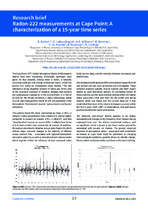| dc.contributor.author | Botha, R. | |
| dc.contributor.author | Labuschagne, C. | |
| dc.contributor.author | Williams, A.G. | |
| dc.contributor.author | Bosman, G. | |
| dc.contributor.author | Brunke, E.-G. | |
| dc.contributor.author | Rossouw, A. | |
| dc.contributor.author | Lindsay, R. | |
| dc.date.accessioned | 2019-10-10T12:54:45Z | |
| dc.date.available | 2019-10-10T12:54:45Z | |
| dc.date.issued | 2018 | |
| dc.identifier.citation | Botha, R., Labuschagne, C., Williams, A.G., Bosman, G., Brunke, E.-G., Rossouw, A., & Lindsay, R.. (2018). Radon-222 measurements at Cape Point: A characterization of a 15 year time series. Clean Air Journal, 28(2), 19-20. https://dx.doi.org/10.17159/2410-972x/2018/v28n2a11 | en_US |
| dc.identifier.issn | 2410-972X | |
| dc.identifier.uri | http://dx.doi.org/10.17159/2410-972x/2018/v28n2a11 | |
| dc.identifier.uri | http://hdl.handle.net/10566/5024 | |
| dc.description.abstract | The Cape Point (CPT) Global Atmosphere Watch (GAW) research
station have been monitoring climatically significant trace
gases for four decades. Among these is radon, a naturally
occurring noble gas with a large continental source, which has
proven very useful for atmospheric tracer studies. 222Rn, the
radioactive decay daughter product of radon gas, forms part
of the long-term exposure of radiation dosages that humans
are continuously exposed to in the environment. In a first of
its kind for the African continent, a radon climatology, based
on a 15-year measurement record at CPT, was published in the
Atmospheric Environment journal (www.elsevier.com/locate/
atmosenv). | en_US |
| dc.language.iso | en | en_US |
| dc.publisher | National Association for Clean Air | en_US |
| dc.subject | Cape Point | en_US |
| dc.subject | Cape Town | en_US |
| dc.subject | Global Atmosphere Watch (GAW) | en_US |
| dc.subject | Radon | en_US |
| dc.subject | Noble gas | en_US |
| dc.title | Radon-222 measurements at Cape Point: A characterization of a 15-year time series | en_US |
| dc.type | Article | en_US |

